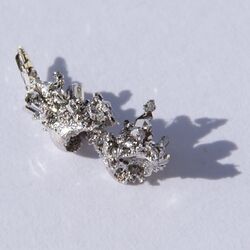Palladium, 46 Palladium Pronunciation (pə-LAY -dee-əm Appearance silvery white Standard atomic weight A r, std (Pd) [1] Palladium in the periodic table
Atomic number (Z ) 46 Group group 10 Period period 5 Block d-block Element category d-block Electron configuration [Kr ] 4d10 Electrons per shell 2, 8, 18, 18 Physical properties Phase at STP solid Melting point 1828.05 K (1554.9 °C, 2830.82 °F) Boiling point 3236 K (2963 °C, 5365 °F) Density (near r.t. ) 12.023 g/cm3 when liquid (at m.p. ) 10.38 g/cm3 Heat of fusion 16.74 kJ/mol Heat of vaporization 358 kJ/mol Molar heat capacity 25.98 J/(mol·K) Vapor pressure
P (Pa)
1
10
100
1 k
10 k
100 k
at T (K)
1721
1897
2117
2395
2753
3234
Atomic properties Oxidation states 0 +2 +4 basic oxide)Electronegativity Pauling scale: 2.20 Ionization energies 1st: 804.4 kJ/mol 2nd: 1870 kJ/mol 3rd: 3177 kJ/mol Atomic radius empirical: 137 pm Covalent radius 139±6 pm Van der Waals radius 163 pm Spectral lines of palladiumOther properties Natural occurrence primordial Crystal structure face-centered cubic (fcc) Speed of sound thin rod 3070 m/s (at 20 °C) Thermal expansion 11.8 µm/(m·K) (at 25 °C) Thermal conductivity 71.8 W/(m·K) Electrical resistivity 105.4 nΩ·m (at 20 °C) Magnetic ordering paramagnetic [2] Magnetic susceptibility +567.4·10−6 cm3 /mol (288 K)[3] Young's modulus 121 GPa Shear modulus 44 GPa Bulk modulus 180 GPa Poisson ratio 0.39 Mohs hardness 4.75 Vickers hardness 400–600 MPa Brinell hardness 320–610 MPa CAS Number 7440-05-3 History Naming after asteroid Pallas , itself named after Pallas Athena Discovery and first isolationWilliam Hyde Wollaston (1802)Main isotopes of palladium
Category: Palladium view · talk · edit references
Pd
data m.p. cat
C
1554.9
—
—
K
1828.05
1828.1
-0.05
delta
F
2830.82
2830.8
0.02
delta
max precision
2
WD
input
C: 1554.9, K: 1828.05, F: 2830.82
comment
Pd
data b.p. cat
C
2963
—
—
K
3236
3236
0
F
5365
5365
0
max precision
0
WD
input
C: 2963, K: 3236, F: 5365
comment
References These references will appear in the article, but this list appears only on this page.
↑ Meija, Juris; Coplen, Tyler B.; Berglund, Michael; Brand, Willi A.; De Bièvre, Paul; Gröning, Manfred; Holden, Norman E.; Irrgeher, Johanna et al . (2016). "Atomic weights of the elements 2013 (IUPAC Technical Report)". Pure and Applied Chemistry 88 (3): 265–91. doi :10.1515/pac-2015-0305 . ↑ Lide, D. R., ed (2005). "Magnetic susceptibility of the elements and inorganic compounds" . CRC Handbook of Chemistry and Physics (86th ed.). Boca Raton (FL): CRC Press. ISBN 0-8493-0486-5 . https://web.archive.org/web/20110303222309/http://www-d0.fnal.gov/hardware/cal/lvps_info/engineering/elementmagn.pdf . ↑ Weast, Robert (1984). CRC, Handbook of Chemistry and Physics . Boca Raton, Florida: Chemical Rubber Company Publishing. pp. E110. ISBN 0-8493-0464-4 . Template:Documentation


